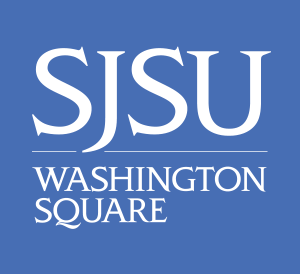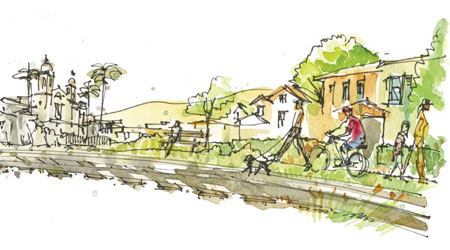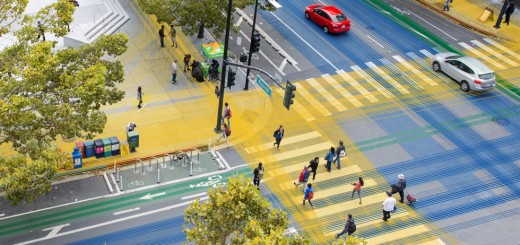Healing Five Wounds
An extraordinary town-gown partnership is turning a modest neighborhood into a model for healthy urban villages of the future
By Lisa Krieger
Mighty Union Pacific trains once pulsed through downtown San José, a land rich with agriculture.
But now both the trains and orchards are gone — leaving behind a skeleton of derelict railroad track and city-dwellers with no easy access to fresh fruits and vegetables.
A broad coalition sees in these remains the seeds of a community renewal. This community-university-city partnership — called CommUniverCity — seeks to use the fallow land to restore health to the working-class neighborhood surrounding Five Wounds Church.
“This is my home, my community. But San José State opened my eyes to the opportunity in this area,” says Monica Gallyot, ’11, one of nearly 7,000 SJSU students who have invested 93,000 hours in CommUniverCity projects.
So far, the efforts of student-faculty-community teams have contributed an estimated $1.8 million worth of volunteer labor to this modest neighborhood. They seek to convert the abandoned railway into a lovely trail. A busy bus stop needs “streetscaping” to be more inviting. Parents and children want safer routes to walk to school. Someday, they hope, a village of shops, cafes and public gathering places will cluster around a future BART station.
Meanwhile, there are ancestral fruit trees, their branches drooping, waiting to be picked. A dusty and neglected parcel next to Coyote Creek could be turned into a community garden. Some neighbors have even stepped forward to lend their yards for use by nearby apartment-dwellers.
If successful, the CommUniverCity teams will build a “small-town” environment in the center of San José, with rich community gardens, walkable streets and thriving retail and business corridors linked to Bay Area mass transit.
Already, the Five Wounds/Brookwood Terrace neighborhood’s concept is serving as a template for the 70 urban villages in San José’s Envision 2040 plan — and could someday be a national model for safe, clean and healthy cities.
Long before these big plans, small ideas were gestating, due to growing discontent.
This community of 20,000 is a largely Spanish-speaking neighborhood that serves as a gateway for recent immigrants from Northern Mexico, yet also holds a solid core of homeowners with a long history of civic engagement.
When resident Joan Rivas-Cosby arrived in 1974, at age 16, “money was tight and this area was very affordable. You made the best of it.
“Things looked in disrepair, a little dilapidated,” recalls Rivas-Cosby, now a leader of the Five Wounds/Brookwood Terrace Neighborhood Action Coalition and a member of the CommUniverCity steering committee. “There were a lot of renters, and owners were uninterested in keeping up the property. There was a lot of graffiti.
“Schools used to be really ugly. The children were just awful. Disrespectful. They had sticks to scratch fences as they walked along. Or carried spray cans openly,” she recalls. “I used to run out of the house screaming at them, to run them off.”
Then San José’s redevelopment funds began to spruce things up. Liquor stores and check-cashing stores vanished. Businesses replaced their facades. Schools began to improve. By the ’90s, several new housing developments attracted more affluent families. Coyote Creek was cleaned. And several stunning new parks were constructed.
But looming problems remain.
The population suffers from chronic health diseases brought on by imbalanced diets, obesity and inactivity. Due to unsafe streets, children don’t walk or bike. Meals tend to be fad-laden, not garden-grown.
“So many people don’t know about health and nutrition. There’s no regular Farmer’s Market. Kids have asthma and can’t run,” says Gallyot.
On its busiest streets, sidewalks are narrow, with no landscaping or other buffers to protect children. There is little signage.
The old railroad track bisects the community, a piece of the past that runs a mile and a half, like urban archeology. Wind-blown seeds have taken root in the track bed, sowing wild grasses. Graffiti sprouts on fences.
Where to look for the solution? In their own community — on front porches and back yards — and in the classrooms and faculty offices of nearby San José State.
“If we plan something now, we won’t be at the mercy of any developer who just chooses to come in,” says Rivas-Cosby.
CommUniverCity started as a small kernel — a core of residents working closely with just a handful of SJSU faculty.
On the community side, strategizing began in 2002 when it was learned that a BART station was being planned behind Five Wounds Church, the beautiful Neo-Baroque church built in 1919 and modeled after the Cathedral of Braga in Northern Portugal.
“We wanted not just a hole, in and out of the ground,” says Imelda Rodriguez, president of the Olinder Neighborhood Association and a member of the CommUniverCity steering committee. “We wanted a village.”
Neighbors sought to ensure that their “small town” vision would be part of that future development. But they worried that their volunteers and city-driven initiatives alone could not sustain them for the long haul.
On campus, meanwhile, SJSU had committed to “service-learning,” where students gain hands-on experience outside the classroom. But the university needed more such projects.
In 2003, then-College of Education Dean Susan Meyers proposed a campus-wide “service-learning” partnership with a San José neighborhood. The Five Wounds/Brookwood Terrace neighborhood was selected in 2004, with a particular focus on health, education, urban planning, anthropology and management of information systems.
By the next summer, a steering committee selected political science professor Terry Christensen as executive director, and presented a menu of projects to the Five Wounds/Brookwood Terrace Neighborhood Advisory Council.
One thing led to another. The turning point was a successful series of community workshops — in English, Spanish and Portuguese — attended by more than 150 residents. Meanwhile, more than 60 San José State urban planning students assisted with research on technical details such as mapping.
Since then, the CommUniverCity partnership has expanded — and attracted funding. Thanks to a $75,000 infusion from the regional nonprofit Health Trust, for example, CommUniverCity is planning a new community garden and a fruit tree-sharing program.
What’s the secret? Looking back, the partners agree that there are essential ingredients behind its success: concerned residents, a committed local government, inspired faculty members — and energetic students.
SJSU is part of an expanding movement across the United States that recognizes that — by the very nature of their stability and long-term presence — urban universities are intimately tied to the fate of their surrounding communities and governments.
Now, each semester, SJSU faculty members and over 1,000 students engage in service-learning projects that advance the community’s dreams.
“The students are wonderful. The work they are doing is invaluable,” said Rivas-Cosby. “It is so exciting to see their energy, purpose and drive.”
Helping plan a community garden on unused Water District property near Coyote Creek, for example, “the students are really helpful in finding out model policies of similar gardens elsewhere in the U.S. — and can help us pick and choose what policies make sense for us,” said SJSU professor Dayana Salazar, an expert in environmental planning and director of CommUniverCity.
In future months, students will be enlisted to help build boxes for a “Garden Sharing” program, where homeowners with large, early-20th-century lots and legacy fruit trees offer garden space to apartment-dwellers. And they could help share the bounty in an upcoming “Fruit Tree Sharing” harvest, picking surplus apricots, peaches and avocados from the trees of generous neighbors.
Students’ contributions to the community are formidable, say neighbors. Through their work, the neighborhood is moving closer to its vision while promoting the health and well-being of its residents.
But the Five Wounds/Brookwood Terrace neighbors give SJSU students a lifelong graduation gift in return.
“They are learning what it takes to build community,” said Rodriguez.
“Now they’re going back to their home neighborhoods and saying, ‘I realize that there are things that my own neighborhood can do, too.’”




